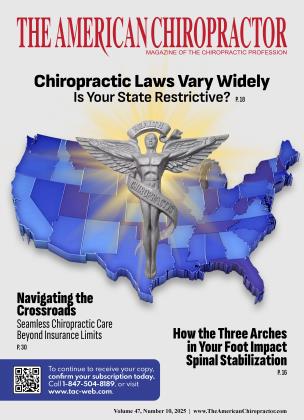Understanding the Benefits and Considerations
October 1 2025 Jamie ForsterUnderstanding the Benefits and Considerations
October 1 2025 Jamie ForsterReasons to Take a Newborn to a Chiropractor
 Dr. Forster’s son Cal at 3yo, advertising his dads office. He is currently 3rd generation and in practice with him.
Dr. Forster’s son Cal at 3yo, advertising his dads office. He is currently 3rd generation and in practice with him.
CHIROPRACTIC CARE FOR NEWBORNS IS UNCONVENTIONAL FOR MANY, but it is growing in popularity for parents seeking natural and conservative approaches to their child’s health and well-being. While most chiropractors are treating adults experiencing back pain, neck pain, headaches, or injuries, chiropractic care for infants is rooted in gentle, specialized techniques that offer countless health benefits.
Here, we will learn why parents are encouraged to take their newborn to a chiropractor and discover some potential advantages and pertinent considerations.
One reason parents take their newborns to see a chiropractor is to support healthy development for physical development (sitting, crawling, walking, jumping) and cognitive skills (recognition/repeat activities, language, comprehension). The birthing process is traumatic and can be physically taxing for the mother and the infant.
A chiropractor can assess a newborn’s cranium, spine, and nervous system alignment, addressing any misalignments that may have occurred during delivery. Early intervention is the best approach to correct minor issues so that they don’t develop into more significant problems later in life.
Procreation and the birthing process are the most beautiful and amazing moments of life, but birth is traumatic. Every newborn would benefit from chiropractic adjustments (mostly cranial) to establish a state of homeostasis.
Going from dark, wet, and warm (98.6 degrees Fahrenheit) to lights, sounds, and breathing air is a transitional trauma. The journey through the birth canal can result in physical stress or injuries to the infant’s body.
Techniques utilized by chiropractors for newborns are gentle and effective (similar to adults with extra attention to a gentle approach) to alleviate the areas of compromise and promote a healing response. It can reduce discomfort and enhance the infant’s ability to rest calmly and thrive.1
There are various adjusting techniques utilized for infants, including cranial adjusting for asymmetry or flat regions. Cranial adjustments in infants can be effectively performed with precise and gentle techniques.
One method involves stabilizing the crown of the head with one hand, while the other hand performs rhythmic, controlled movements over the frontal bone, sphenoid bone, or maxilla. In cases where asymmetry is observed, such as flattening in the temporal or occipital areas, the occipital ridge can serve as an anatomical contact point. Applying gentle upward traction from an inferior to superior direction on the occipital ridge facilitates the rounding of the cranium and supports cranial symmetry.
Cervical traction (manual non-force) to resolve torticollis, thoracic adjustments, and extremity adjusting can be helpful. Hip click and knee click are common conditions, but the talus subluxation is by far the most common adjustment needed to address in-toeing (pigeon-toed) and out-toeing issues. The procedure involves axial traction, and most talus adjustments result in an audible and palpable osseous release.
Another example of common practice is correction of the sacrum. The examination and analysis of the sacrum is performed by approximating the gluteal fold. The tissue will veer straight up the midline or fork left or right, and the significance of the tissue fold reveals the side of the anteriorly misaligned sacral base. The adjustment is performed with an adjusting instrument, and results are usually immediate.
Inversion is also performed on children from birth to three years old to support the flow of CSF (cerebrospinal fluid) due to their C-shaped spines. All pediatric chiropractic techniques of adjusting require proper training from an experienced chiropractor.
A critical point to make is the importance of adjusting the mother during the entire pregnancy, and how many chiropractors are treating the mother postpartum? Lumbar and pelvic adjustments are crucial after delivering a baby.
 Jamie being adjusted by his dad in 1963
Jamie being adjusted by his dad in 1963
Sleep is crucial for everyone, but it impacts a newborn’s growth and brain development. Parents consistently report that chiropractic adjustments help their baby’s sleep patterns due to the spine and nervous system functioning optimally. When an infant is free from physical discomfort, they are more likely to experience regular and restful sleep, resulting in consistent growth and proper development.
Chiropractic care also aids in reducing common digestive issues seen in newborns, such as colic, constipation, and reflux. Misaligmnents in the spine, as well as spastic intestinal valves (cardiac sphincter, pyloric, ileocecal, Houston’s), can influence the function of the digestive system.
Chiropractic adjustments alleviate these uncomfortable conditions, leading to a happier and healthier baby. When a mother is breastfeeding, everything she ingests will affect the baby’s digestion.
A homeostatic state is essential for the optimal functioning of the nervous system, which plays a significant role in brain development. The brain begins to develop two to three weeks into gestation. At birth, we have approximately 86 billion neurons (nerve cells).2
From birth to three years old, the brain will create more than one million connections (synapses) every second. The baby’s first words and steps reflect changes and development in their brain.3
By ensuring that a newborn is correctly aligned and nutritionally supported (high-quality fish oil,4-5 vitamin D3 [“vitamin D may be important for neurodevelopment”6], chiropractic care may enhance their brain development and function.8 In fact, a meta-analysis of randomized clinical trials shows that probiotics provide great support for levels of BDNF (brain-derived neurotrophic factor) and “a mixture of Lactobacillus and Bifidobacterium varieties appear to show greater efficacy than the single genus supplement” when it comes to support.7b
 Jamie adjusting his son Cal at 2yrs old
Jamie adjusting his son Cal at 2yrs old
This proactive approach to health is particularly beneficial during the early stages of life when an infant’s nervous system is still developing. The frontal lobe of the brain, which includes the prefrontal cortex, develops postpartum.
The first few years are critically influential, but the frontal lobe will continue to develop until 21 to 25 years old. The development of the prefrontal cortex allows for memory, planning, imagination, inhibitory control, walking, speech, and problem solving.
Eicosapentaenoic acid (EPA) acts as an anti-inflammatory agent,9 whereas docosapentaenoic acid (DHA) has more support influence on brain activity and neuroplasticity.10 Ratios for children’s fish oil may differ and can possibly have more DHA than EPA in the formula. The importance of cofactors is stressed because they can support proper absorption and utilization of fatty acids as well as ameliorate oxidation that takes place when fatty acids are being metabolized.
Cofactors assist with multiple biological/biochemical reactions. The most popular cofactors are B vitamins, which may act to facilitate and catalyze metabolic enzymatic reactions. Additionally, water-soluble antioxidants, such as vitamin C, and fat-soluble antioxidants, such as alpha lipoic acid, CoQlO, and glutathione, act as cofactors to guard against oxidation of fish oil fatty acids.11
Techniques employed for pediatric chiropractic care are very different from those utilized with adult care. Pediatric chiropractic adjustments are gentle, noninvasive, and specifically tailored to the individual infant’s needs. Some of my infant patients stare at me the whole time; some of them fall asleep; and some cry because they don’t like to feel restricted, or they lack familiarity.
 Dr. Jamie Forster at his office with pediatric patients
Dr. Jamie Forster at his office with pediatric patients
Ensuring adequate intake of key vitamins and nutrients when planning to conceive (and also during pregnancy) is crucial for gestation, fetal development, and the overall wellness of mother and baby. Vitamins B6, B9 (folate), and B12 are especially important.
“Vitamin B6 plays a significant role in hormone regulation. This is vital for healthy menstrual cycles and ovulatory cycles, which are independent functions.”
Support for hormone regulation, morning sickness (nausea), and immune function.
Vitamin B6 plays a significant role in hormone regulation. This is vital for healthy menstrual cycles and ovulatory cycles, which are independent functions. This simple nutrient helps balance progesterone and estrogen levels,12 which may be favorable for implantation given the effect of progesterone on implantation.13
Pyridoxal-5-phosphate (P-5-P) is the activated form of vitamin B6. Recent research indicates that vitamin B6 can be helpful support for women at high risk for postpartum depression.14
Supports functional cell maturation, cell growth and function, healthy tissue/organ growth, and full-term pregnancy.
Folate is crucial in providing an environment for healthy tissue development that is void of dysfunction. Folate is instrumental in the homocysteine pathway, and lack of folate can lead to problems from tissue destruction because of high homocysteine.
All significant biomarkers, such as homocysteine, creatine kinase (measuring catabolic action), and C-reactive protein (CRP, indicating inflammation levels), should be checked four to six months prior to conception to ensure optimal levels. A methylated form of folate, such as L-5 methyltetrahydrofolate (5-MTHF), is recommended because 50% of the population carries a gene variation (MTHFR) that impedes their ability to metabolize inactive folic acid.
 Dr. Jamie Forster at his office with pediatric patients
Dr. Jamie Forster at his office with pediatric patients
“5-MTHFolate early supplementation seems to support the increase in size of the surface area in the parietal cortex... This lobe has been involved in sensory processing and visual motor control, attention processing, touch and grasping, other superior cognitive functions...This increased surface area is coherent to attentional processing advantages observed in children of 5 -MTHF - supplemented mothers. ”15
Supports nervous system health, healthy red blood cells, and energy production.
Vitamin B12 is another vital and essential nutrient for the nervous system. It aids in myelin formation as well as brain and spinal cord development of the fetus.
Adequate intake of these vitamins can help ensure the support of a healthy full-term pregnancy and contribute to optimal fetal development. Individuals planning to conceive should consider consulting with healthcare professionals to customize their supplement program to their individual, specific needs. This can help set a foundation for future growth and wellness.
In our practice, we use a comprehensive multivitamin mineral supplement with activated B vitamins as the prenatal and postnatal supplements to supply the necessary nutrients. Prenatal vitamins taken along with prenatal minerals supply the necessary nutrients for the mother and fetus. This dynamic duo is great support for preconception and gestational phases, and it gives the practitioner more independence with variable dosing based on the individual patient’s needs.
In conclusion, having a newborn adjusted by a chiropractor can offer various benefits that support healthy development, address birth trauma, support improved sleep patterns, promote healthy digestion, optimize immune function, and support breastfeeding issues. The gentle, noninvasive chiropractic techniques used by pediatric chiropractors are tailored specifically to infants to give a safe, comfortable, and nontraumatic experience.
As with any healthcare decision, parents are encouraged to research and get referrals to arrange for a consultation with a qualified professional to determine the best course of action for their infant’s well-being. Taking these steps helps ensure that parents are making an educated decision for their child’s early health and development, setting a solid foundation for their growth and success.

Dr. James Forster, a chiropractor since 1985, was mentored by his father, AK pioneer Dr. Arnold Forster. He operates a successful NYCbased practice, teaches applied kinesiology and functional medicine, and toured with the Ramones as their chiropractor. He has treated infants and children since 1985. His mission is to educate peers on integrative care through labs, nutrition, and lifestyle. Contact info: [email protected], [email protected].
References
1. Conti F, McCue JJ, DiTuro P, Galpin AJ, Wood TR. Mitigating traumatic brain injury: a narrative review of supplementation and dietary protocols. Nutrients. 2024 Jul 26;16(15):2430. doi: 10.3390/nul6152430. PMID: 39125311; PMCID: PMC11314487.
2. Janssen CI, Zerbi V, Mutsaers MP, de Jong BS, Wiesmann M, Arnoldussen IA, Geenen B, Heerschap A, Muskiet FA, Jouni ZE, van Tol EA, Gross G, Homberg JR, Berg BM, Kiliaan AJ. Impact of dietary n-3 polyunsaturated fatty acids on cognition, motor skills and hippocampal neurogenesis in developing C57BL/6J mice. J Nutr Biochem. 2015 Jan;26(l):24-35. doi: 10.1016/j.jnutbio.2014.08.002. Epub 2014 Sep 28. PMID: 25444517.
3. Herculano-Houzel S. The human brain in numbers: a linearly scaled-up primate brain. Front Hum Neurosci. 2009 Nov 9;3:31. doi: 10.3389/neuro.09.031.2009. PMID: 19915731; PMCID: PMC2776484.
4. Moltu SJ, Nordvik T, Rossholt ME, Wendel K, Chawla M, Server A, Gunnarsdottir G, Pripp AH, Domellof M, Bratlie M, Aas M, Hiippi PS, Lapillonne A, Beyer MK, Stiris T, Maximov II, Geier O, Pfeiffer H. Arachidonic and docosahexaenoic acid supplementation and brain maturation in preterm infants; a double blind RCT Clin Nutr. 2024 Jan;43(l):176186. doi: 10.1016/j.clnu.2023.11.037. Epub 2023 Nov 29. PMID: 38061271.
5. Helland IB, Smith L, Saarem K, Saugstad OD, Drevon CA. Maternal supplementation with very-long-chain n-3 fatty acids during pregnancy and lactation augments children's IQ at 4 years of age. Pediatrics. 2003 Jan;lll(l):e39-44. doi: 10.1542/ peds.lll.l.e39. PMID: 12509593.
6. Tuovinen S, Raikkonen K, Holmlund-Suila E, Hauta-Alus H, Helve O, Rosendahl J, Enlund-Cerullo M, Kajantie E, Valkama S, Viljakainen H, Makitie O, Andersson S, Heinonen K. Effect of high-dose vs standard-dose vitamin D supplementation on neurodevelopment of healthy term infants: a randomized clinical tTrial. JAMA Netw Open. 2021 Sep l;4(9):e2124493. doi: 10.1001/jamanetworkopen. 2021. 24493. PMID: 34495336; PMCID: PMC8427371.
7. 7a. Santocchi E, Guiducci L, Fulceri F, Billeci L, Buzzigoli E, Apicella F, Calderoni S, Grossi E, Morales MA, Muratori F. Gut to brain interaction in autism spectrum disorders: a randomized controlled trial on the role of probiotics on clinical, biochemical and neurophysiological parameters. BMC Psychiatry. 2016 Jun4;16:183. doi: 10.1186/sl2888-016-08875. PMID: 27260271; PMCID: PMC4893248.
7b. Dehghani F, Abdollahi S, Shidfar F, Clark CCT, Soltani S. Probiotics supplementation and brain-derived neurotrophic factor (BDNF): a systematic review and meta-analysis of randomized controlled trials. Nutr Neurosci. 2023 Oct;26(10):942-952. doi: 10.1080/1028415X.2022.2110664. Epub 2022 Aug 22. PMID: 35996352.
8. Beier F, Loffler M, Nees F, Bekrater-Bodmann R, Silvoni S, Desch S, Loffler A, Hausner L, Frolich L, Flor H. Effects of an app-based sensorimotor training in promoting neuroplasticity and neuropsychological functioning in frailty: A randomized controlled trial. Arch Gerontol Geriatr. 2023 Dec;l 15:105202. doi: 10.1016/j.archger.2023.105202. Epub 2023 Sep 17. PMID: 37776754.
9. da Cruz Nascimento SS, Carvalho de Queiroz JL, Fernandes de Medeiros A, de Franca Nunes AC, Piuvezam G, Lima Maciel BL, Souza Passos T, Morais AHA. Anti-inflammatory agents as modulators of the inflammation in adipose tissue: A systematic review. PLoSOne. 2022 Sep l;17(9):e0273942. doi: 10.1371/journal, pone. 0273942. PMID: 36048868; PMCID: PMC9436134.
10. Hachem M, Nacir H. Emerging role of phospholipids and lysophospholipids for improving brain docosahexaenoic acid as potential preventive and therapeutic strategies for neurological diseases. Int J Mol Sci. 2022 Apr 2;23(7):3969. doi: 10.3390/ijms23073969. PMID: 35409331; PMCID: PMC9000073.
11. Valgimigli L. Lipid Peroxidation and antioxidant protection. Biomolecules. 2023 Aug 24;13(9):1291. doi: 10.3390/ biom!3091291. PMID: 37759691; PMCID: PMC10526874.
12. Zhao Y, Hu S, Zhai W, Wang M, Ran L. Clinical study of progesterone combined with vitamin B6 in the treatment of amenorrhea endocrine disorders caused by antipsychotics. Comput Math Methods Med". 2022 Aug 28:2022:2436322. doi: 10.1155/2022/2436322. Retraction in: Comput Math Methods Med. 2023 Dec 6:2023:9804581. doi: 10.1155/2023/9804581. PMID: 36072776; PMCID: PMC9441377.
13. Gunther V, Allahqoli L, Deenadayal-Mettler A, Maass N, Mettler L, Gitas G, Andresen K, Schubert M, Ackermann J, von Otte S, Alkatout I. Molecular determinants of uterine receptivity: comparison of successful implantation, recurrent miscarriage, and recurrent implantation failure. Int J Mol Sci. 2023 Dec 18;24(24): 17616. doi: 10.3390/ ijms242417616. PMID: 38139443; PMCID: PMC10743587.
14. Khodadad M, Bahadoran P, Kheirabadi GR, Sabzghabaee AM. Can vitamin B6 help to prevent postpartum depression? a randomized controlled trial. Int J Prev Med. 2021 Oct 19:12:136. doi: 10.4103/ijpvm. HPVM 240 19. PMID: 34912512; PMCID: PMC8631136.
15. Catena A, Martinez-Zaldivar C, Diaz-Piedra C, Torres-Espinola FJ, Brandi P, Pdrez-Garcla M, Decsi T, Koletzko B, Campoy C. On the relationship between head circumference, brain size, prenatal long-chain PUFA/5 -methy Itetrahy drofol ate suppl ementation and cognitive abilities during childhood. Br J Nutr. 2019 Sep;122(sl):S40-S48. doi: 10.1017/S0007114516004281. Epub 2017 Mar 29. PMID: 28351446.
NEW PODCAST EPISODES
Find out the latest Tic Talk Podcasts episodes. www.Tic-Talk.net
 View Full Issue
View Full Issue









